Comprehensive Pain Assessment Strategy: Patient Outcomes
VerifiedAdded on 2021/06/17
|12
|3499
|499
Report
AI Summary
This report provides a comprehensive overview of pain assessment strategies, emphasizing the importance of a patient-centered approach. It begins by highlighting the significance of acknowledging the patient's pain experience and establishing therapeutic interactions to build trust and encourage open communication. The report then delves into the use of clinical reasoning and critical thinking by nurses to assess the patient's condition, formulate assessment plans, and determine appropriate treatment options. It stresses the necessity of acquiring the proper equipment for prompt pain assessment and details the process of assessing the patient's pain, including a review of the patient's medical history, pain location, duration, and characteristics. Furthermore, the report underscores the importance of cleaning, replacing, and disposing of used equipment to maintain hygiene and safety, followed by the crucial step of documenting the patient's experience, the assessment performed, and the implementation of pain relief strategies. Finally, the report concludes with a reflection on the assessment approach and outcomes, both reported by the patient and observed by the healthcare provider, emphasizing the need for continuous evaluation and adjustment of pain management techniques to optimize patient outcomes.
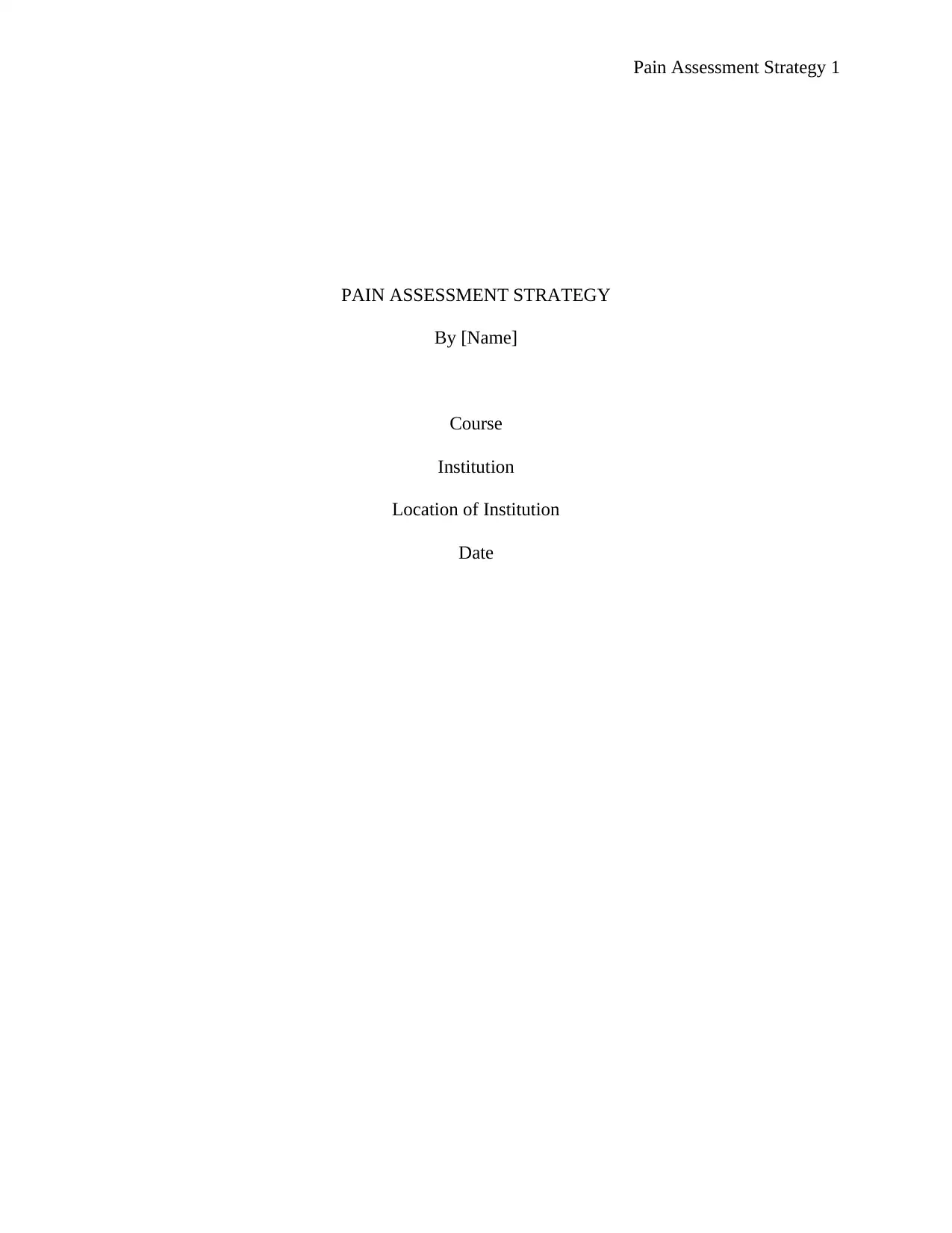
Pain Assessment Strategy 1
PAIN ASSESSMENT STRATEGY
By [Name]
Course
Institution
Location of Institution
Date
PAIN ASSESSMENT STRATEGY
By [Name]
Course
Institution
Location of Institution
Date
Paraphrase This Document
Need a fresh take? Get an instant paraphrase of this document with our AI Paraphraser
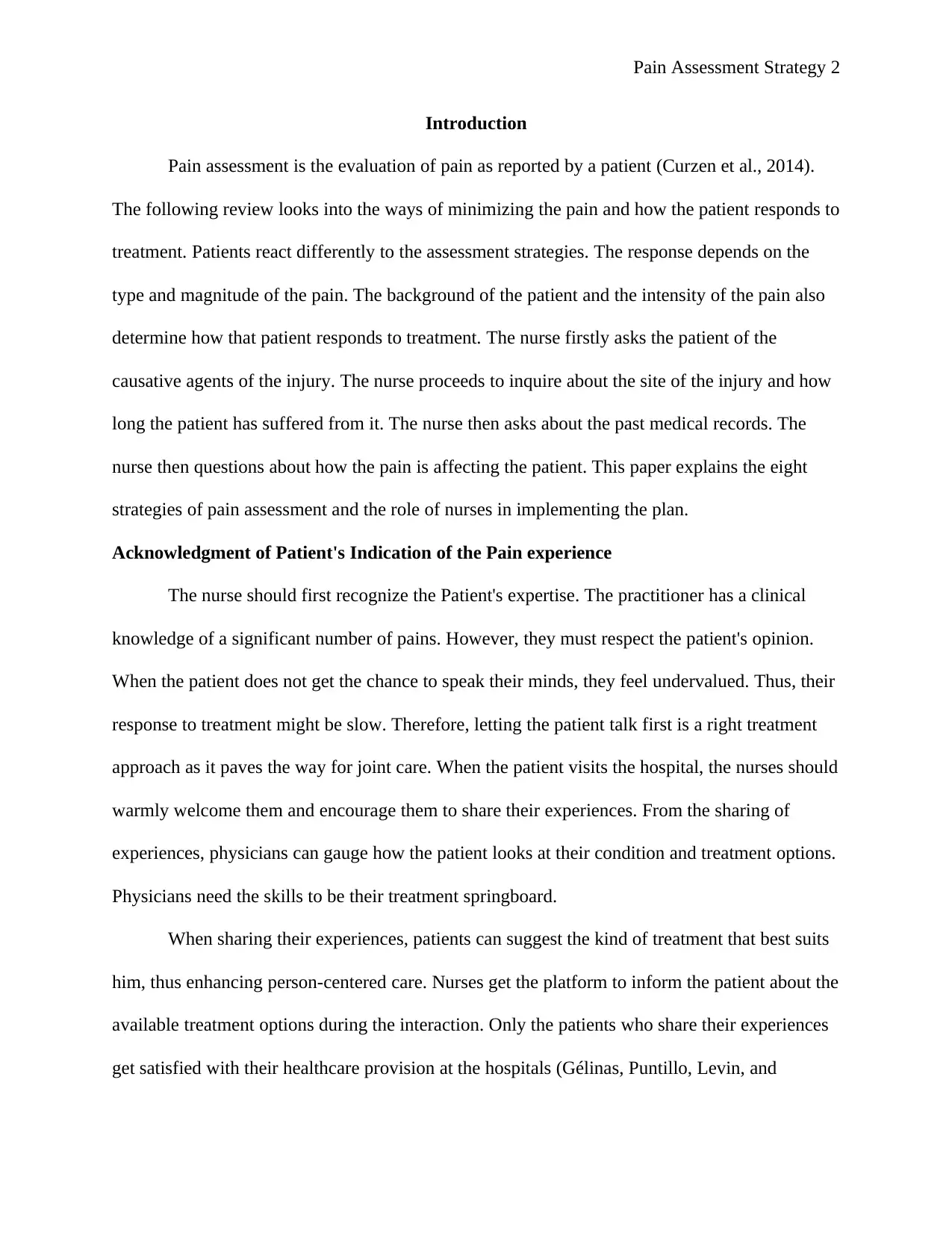
Pain Assessment Strategy 2
Introduction
Pain assessment is the evaluation of pain as reported by a patient (Curzen et al., 2014).
The following review looks into the ways of minimizing the pain and how the patient responds to
treatment. Patients react differently to the assessment strategies. The response depends on the
type and magnitude of the pain. The background of the patient and the intensity of the pain also
determine how that patient responds to treatment. The nurse firstly asks the patient of the
causative agents of the injury. The nurse proceeds to inquire about the site of the injury and how
long the patient has suffered from it. The nurse then asks about the past medical records. The
nurse then questions about how the pain is affecting the patient. This paper explains the eight
strategies of pain assessment and the role of nurses in implementing the plan.
Acknowledgment of Patient's Indication of the Pain experience
The nurse should first recognize the Patient's expertise. The practitioner has a clinical
knowledge of a significant number of pains. However, they must respect the patient's opinion.
When the patient does not get the chance to speak their minds, they feel undervalued. Thus, their
response to treatment might be slow. Therefore, letting the patient talk first is a right treatment
approach as it paves the way for joint care. When the patient visits the hospital, the nurses should
warmly welcome them and encourage them to share their experiences. From the sharing of
experiences, physicians can gauge how the patient looks at their condition and treatment options.
Physicians need the skills to be their treatment springboard.
When sharing their experiences, patients can suggest the kind of treatment that best suits
him, thus enhancing person-centered care. Nurses get the platform to inform the patient about the
available treatment options during the interaction. Only the patients who share their experiences
get satisfied with their healthcare provision at the hospitals (Gélinas, Puntillo, Levin, and
Introduction
Pain assessment is the evaluation of pain as reported by a patient (Curzen et al., 2014).
The following review looks into the ways of minimizing the pain and how the patient responds to
treatment. Patients react differently to the assessment strategies. The response depends on the
type and magnitude of the pain. The background of the patient and the intensity of the pain also
determine how that patient responds to treatment. The nurse firstly asks the patient of the
causative agents of the injury. The nurse proceeds to inquire about the site of the injury and how
long the patient has suffered from it. The nurse then asks about the past medical records. The
nurse then questions about how the pain is affecting the patient. This paper explains the eight
strategies of pain assessment and the role of nurses in implementing the plan.
Acknowledgment of Patient's Indication of the Pain experience
The nurse should first recognize the Patient's expertise. The practitioner has a clinical
knowledge of a significant number of pains. However, they must respect the patient's opinion.
When the patient does not get the chance to speak their minds, they feel undervalued. Thus, their
response to treatment might be slow. Therefore, letting the patient talk first is a right treatment
approach as it paves the way for joint care. When the patient visits the hospital, the nurses should
warmly welcome them and encourage them to share their experiences. From the sharing of
experiences, physicians can gauge how the patient looks at their condition and treatment options.
Physicians need the skills to be their treatment springboard.
When sharing their experiences, patients can suggest the kind of treatment that best suits
him, thus enhancing person-centered care. Nurses get the platform to inform the patient about the
available treatment options during the interaction. Only the patients who share their experiences
get satisfied with their healthcare provision at the hospitals (Gélinas, Puntillo, Levin, and
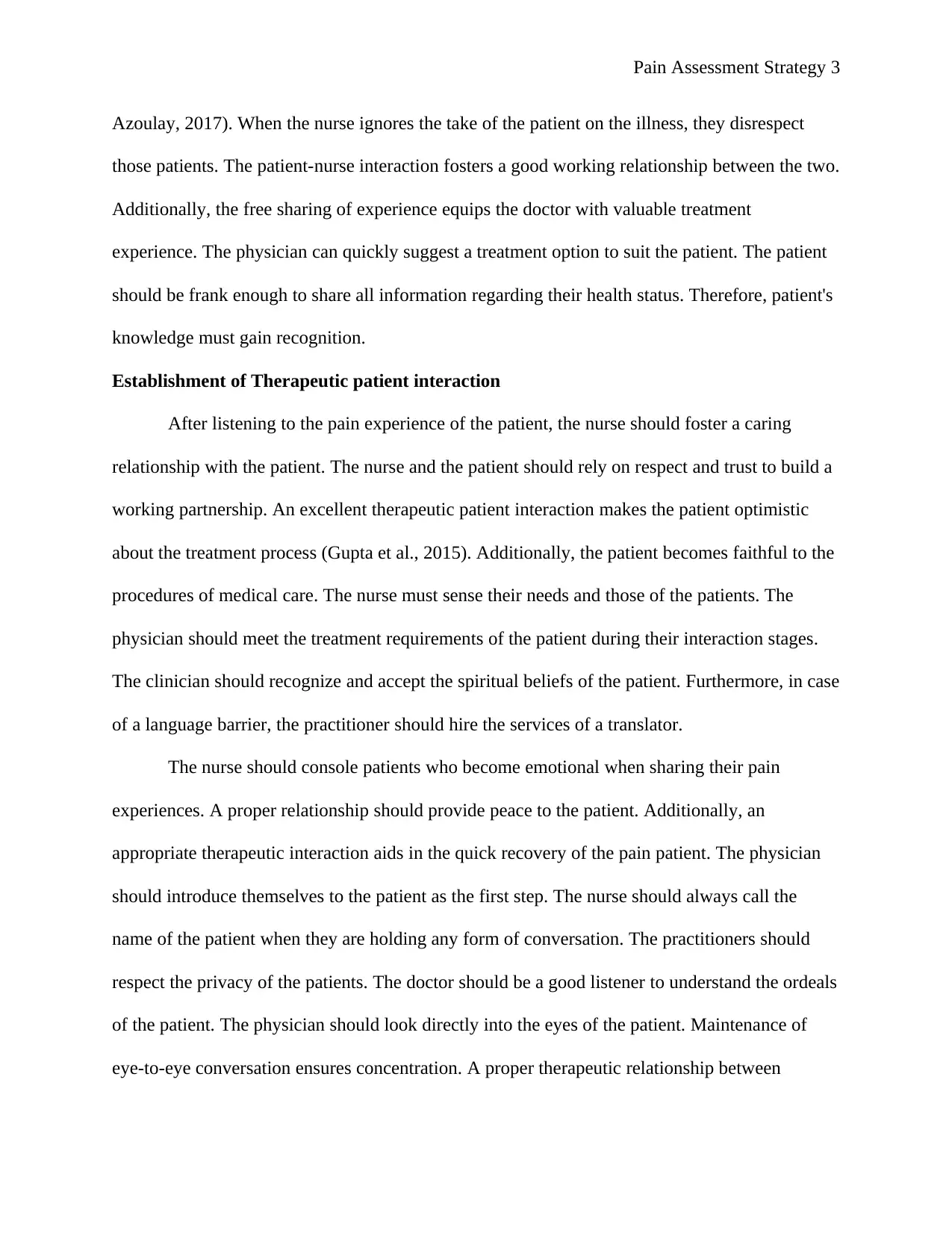
Pain Assessment Strategy 3
Azoulay, 2017). When the nurse ignores the take of the patient on the illness, they disrespect
those patients. The patient-nurse interaction fosters a good working relationship between the two.
Additionally, the free sharing of experience equips the doctor with valuable treatment
experience. The physician can quickly suggest a treatment option to suit the patient. The patient
should be frank enough to share all information regarding their health status. Therefore, patient's
knowledge must gain recognition.
Establishment of Therapeutic patient interaction
After listening to the pain experience of the patient, the nurse should foster a caring
relationship with the patient. The nurse and the patient should rely on respect and trust to build a
working partnership. An excellent therapeutic patient interaction makes the patient optimistic
about the treatment process (Gupta et al., 2015). Additionally, the patient becomes faithful to the
procedures of medical care. The nurse must sense their needs and those of the patients. The
physician should meet the treatment requirements of the patient during their interaction stages.
The clinician should recognize and accept the spiritual beliefs of the patient. Furthermore, in case
of a language barrier, the practitioner should hire the services of a translator.
The nurse should console patients who become emotional when sharing their pain
experiences. A proper relationship should provide peace to the patient. Additionally, an
appropriate therapeutic interaction aids in the quick recovery of the pain patient. The physician
should introduce themselves to the patient as the first step. The nurse should always call the
name of the patient when they are holding any form of conversation. The practitioners should
respect the privacy of the patients. The doctor should be a good listener to understand the ordeals
of the patient. The physician should look directly into the eyes of the patient. Maintenance of
eye-to-eye conversation ensures concentration. A proper therapeutic relationship between
Azoulay, 2017). When the nurse ignores the take of the patient on the illness, they disrespect
those patients. The patient-nurse interaction fosters a good working relationship between the two.
Additionally, the free sharing of experience equips the doctor with valuable treatment
experience. The physician can quickly suggest a treatment option to suit the patient. The patient
should be frank enough to share all information regarding their health status. Therefore, patient's
knowledge must gain recognition.
Establishment of Therapeutic patient interaction
After listening to the pain experience of the patient, the nurse should foster a caring
relationship with the patient. The nurse and the patient should rely on respect and trust to build a
working partnership. An excellent therapeutic patient interaction makes the patient optimistic
about the treatment process (Gupta et al., 2015). Additionally, the patient becomes faithful to the
procedures of medical care. The nurse must sense their needs and those of the patients. The
physician should meet the treatment requirements of the patient during their interaction stages.
The clinician should recognize and accept the spiritual beliefs of the patient. Furthermore, in case
of a language barrier, the practitioner should hire the services of a translator.
The nurse should console patients who become emotional when sharing their pain
experiences. A proper relationship should provide peace to the patient. Additionally, an
appropriate therapeutic interaction aids in the quick recovery of the pain patient. The physician
should introduce themselves to the patient as the first step. The nurse should always call the
name of the patient when they are holding any form of conversation. The practitioners should
respect the privacy of the patients. The doctor should be a good listener to understand the ordeals
of the patient. The physician should look directly into the eyes of the patient. Maintenance of
eye-to-eye conversation ensures concentration. A proper therapeutic relationship between
⊘ This is a preview!⊘
Do you want full access?
Subscribe today to unlock all pages.

Trusted by 1+ million students worldwide
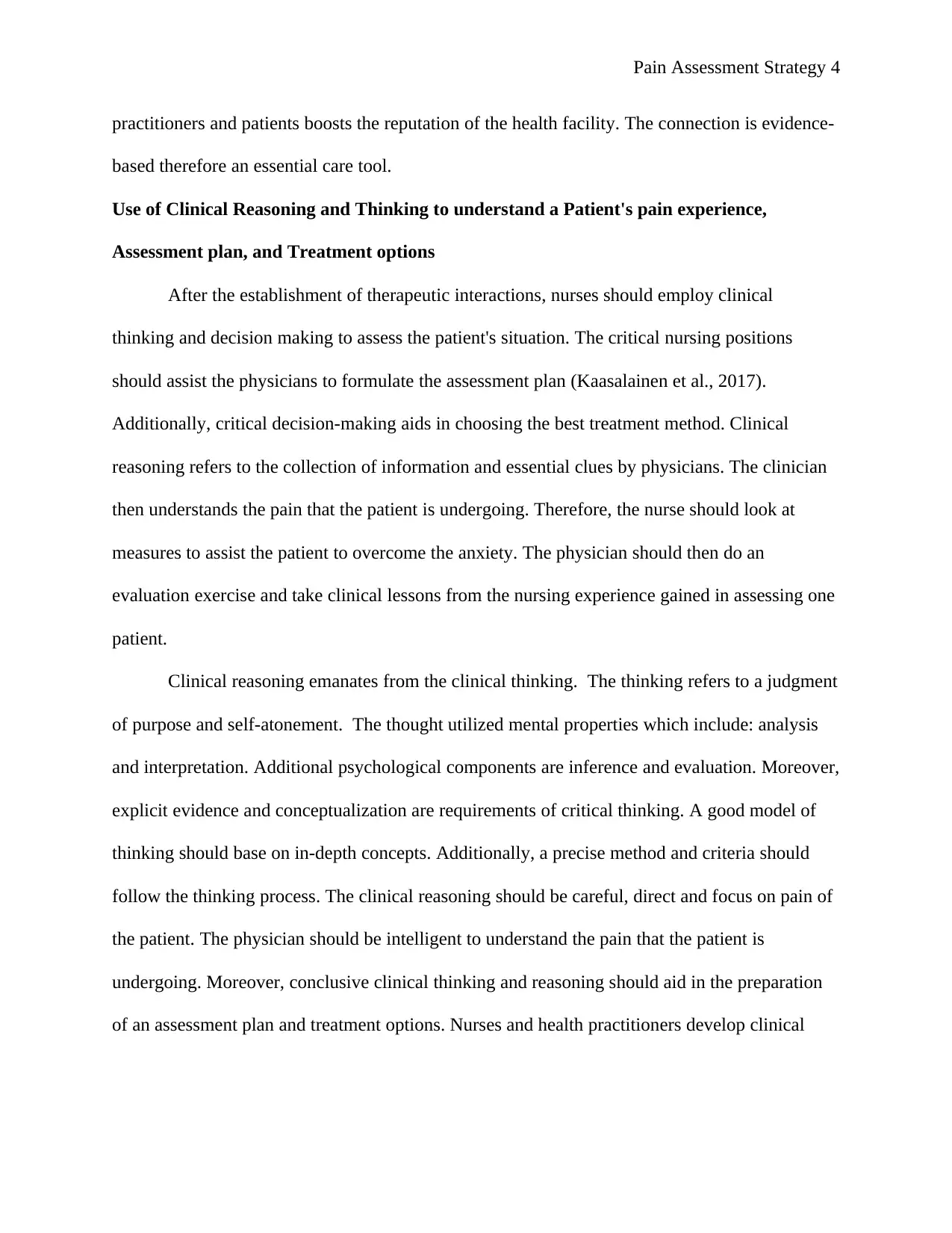
Pain Assessment Strategy 4
practitioners and patients boosts the reputation of the health facility. The connection is evidence-
based therefore an essential care tool.
Use of Clinical Reasoning and Thinking to understand a Patient's pain experience,
Assessment plan, and Treatment options
After the establishment of therapeutic interactions, nurses should employ clinical
thinking and decision making to assess the patient's situation. The critical nursing positions
should assist the physicians to formulate the assessment plan (Kaasalainen et al., 2017).
Additionally, critical decision-making aids in choosing the best treatment method. Clinical
reasoning refers to the collection of information and essential clues by physicians. The clinician
then understands the pain that the patient is undergoing. Therefore, the nurse should look at
measures to assist the patient to overcome the anxiety. The physician should then do an
evaluation exercise and take clinical lessons from the nursing experience gained in assessing one
patient.
Clinical reasoning emanates from the clinical thinking. The thinking refers to a judgment
of purpose and self-atonement. The thought utilized mental properties which include: analysis
and interpretation. Additional psychological components are inference and evaluation. Moreover,
explicit evidence and conceptualization are requirements of critical thinking. A good model of
thinking should base on in-depth concepts. Additionally, a precise method and criteria should
follow the thinking process. The clinical reasoning should be careful, direct and focus on pain of
the patient. The physician should be intelligent to understand the pain that the patient is
undergoing. Moreover, conclusive clinical thinking and reasoning should aid in the preparation
of an assessment plan and treatment options. Nurses and health practitioners develop clinical
practitioners and patients boosts the reputation of the health facility. The connection is evidence-
based therefore an essential care tool.
Use of Clinical Reasoning and Thinking to understand a Patient's pain experience,
Assessment plan, and Treatment options
After the establishment of therapeutic interactions, nurses should employ clinical
thinking and decision making to assess the patient's situation. The critical nursing positions
should assist the physicians to formulate the assessment plan (Kaasalainen et al., 2017).
Additionally, critical decision-making aids in choosing the best treatment method. Clinical
reasoning refers to the collection of information and essential clues by physicians. The clinician
then understands the pain that the patient is undergoing. Therefore, the nurse should look at
measures to assist the patient to overcome the anxiety. The physician should then do an
evaluation exercise and take clinical lessons from the nursing experience gained in assessing one
patient.
Clinical reasoning emanates from the clinical thinking. The thinking refers to a judgment
of purpose and self-atonement. The thought utilized mental properties which include: analysis
and interpretation. Additional psychological components are inference and evaluation. Moreover,
explicit evidence and conceptualization are requirements of critical thinking. A good model of
thinking should base on in-depth concepts. Additionally, a precise method and criteria should
follow the thinking process. The clinical reasoning should be careful, direct and focus on pain of
the patient. The physician should be intelligent to understand the pain that the patient is
undergoing. Moreover, conclusive clinical thinking and reasoning should aid in the preparation
of an assessment plan and treatment options. Nurses and health practitioners develop clinical
Paraphrase This Document
Need a fresh take? Get an instant paraphrase of this document with our AI Paraphraser
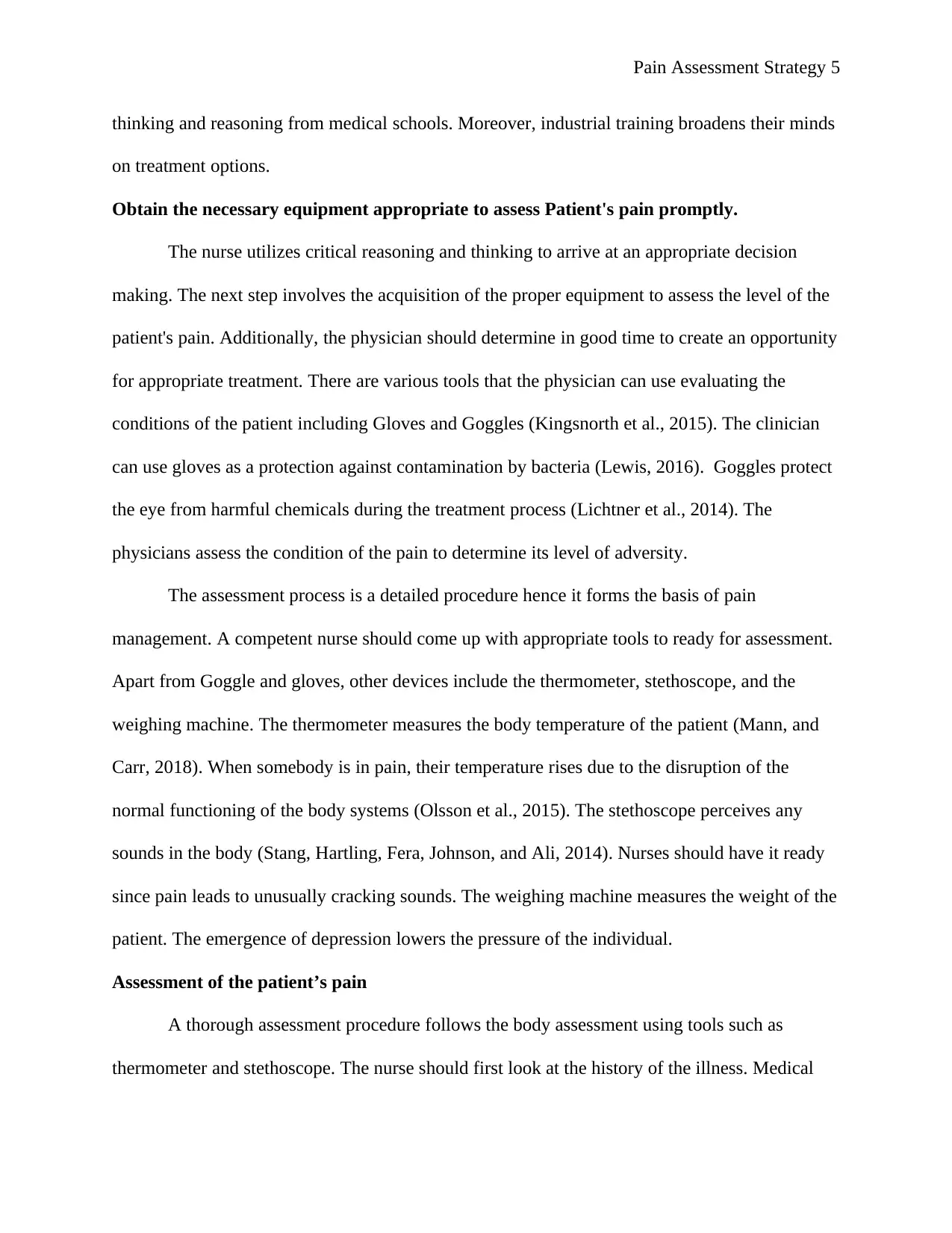
Pain Assessment Strategy 5
thinking and reasoning from medical schools. Moreover, industrial training broadens their minds
on treatment options.
Obtain the necessary equipment appropriate to assess Patient's pain promptly.
The nurse utilizes critical reasoning and thinking to arrive at an appropriate decision
making. The next step involves the acquisition of the proper equipment to assess the level of the
patient's pain. Additionally, the physician should determine in good time to create an opportunity
for appropriate treatment. There are various tools that the physician can use evaluating the
conditions of the patient including Gloves and Goggles (Kingsnorth et al., 2015). The clinician
can use gloves as a protection against contamination by bacteria (Lewis, 2016). Goggles protect
the eye from harmful chemicals during the treatment process (Lichtner et al., 2014). The
physicians assess the condition of the pain to determine its level of adversity.
The assessment process is a detailed procedure hence it forms the basis of pain
management. A competent nurse should come up with appropriate tools to ready for assessment.
Apart from Goggle and gloves, other devices include the thermometer, stethoscope, and the
weighing machine. The thermometer measures the body temperature of the patient (Mann, and
Carr, 2018). When somebody is in pain, their temperature rises due to the disruption of the
normal functioning of the body systems (Olsson et al., 2015). The stethoscope perceives any
sounds in the body (Stang, Hartling, Fera, Johnson, and Ali, 2014). Nurses should have it ready
since pain leads to unusually cracking sounds. The weighing machine measures the weight of the
patient. The emergence of depression lowers the pressure of the individual.
Assessment of the patient’s pain
A thorough assessment procedure follows the body assessment using tools such as
thermometer and stethoscope. The nurse should first look at the history of the illness. Medical
thinking and reasoning from medical schools. Moreover, industrial training broadens their minds
on treatment options.
Obtain the necessary equipment appropriate to assess Patient's pain promptly.
The nurse utilizes critical reasoning and thinking to arrive at an appropriate decision
making. The next step involves the acquisition of the proper equipment to assess the level of the
patient's pain. Additionally, the physician should determine in good time to create an opportunity
for appropriate treatment. There are various tools that the physician can use evaluating the
conditions of the patient including Gloves and Goggles (Kingsnorth et al., 2015). The clinician
can use gloves as a protection against contamination by bacteria (Lewis, 2016). Goggles protect
the eye from harmful chemicals during the treatment process (Lichtner et al., 2014). The
physicians assess the condition of the pain to determine its level of adversity.
The assessment process is a detailed procedure hence it forms the basis of pain
management. A competent nurse should come up with appropriate tools to ready for assessment.
Apart from Goggle and gloves, other devices include the thermometer, stethoscope, and the
weighing machine. The thermometer measures the body temperature of the patient (Mann, and
Carr, 2018). When somebody is in pain, their temperature rises due to the disruption of the
normal functioning of the body systems (Olsson et al., 2015). The stethoscope perceives any
sounds in the body (Stang, Hartling, Fera, Johnson, and Ali, 2014). Nurses should have it ready
since pain leads to unusually cracking sounds. The weighing machine measures the weight of the
patient. The emergence of depression lowers the pressure of the individual.
Assessment of the patient’s pain
A thorough assessment procedure follows the body assessment using tools such as
thermometer and stethoscope. The nurse should first look at the history of the illness. Medical
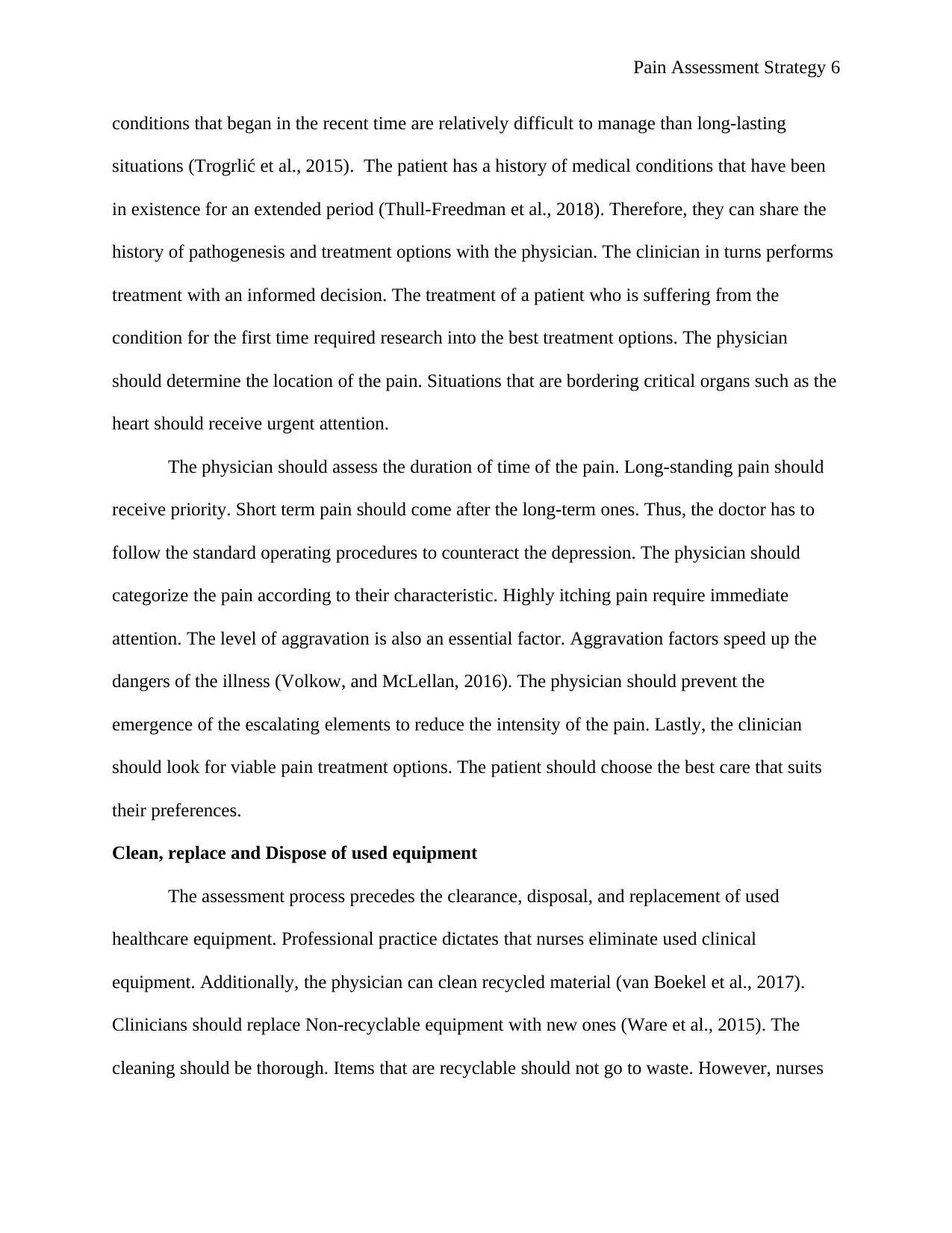
Pain Assessment Strategy 6
conditions that began in the recent time are relatively difficult to manage than long-lasting
situations (Trogrlić et al., 2015). The patient has a history of medical conditions that have been
in existence for an extended period (Thull-Freedman et al., 2018). Therefore, they can share the
history of pathogenesis and treatment options with the physician. The clinician in turns performs
treatment with an informed decision. The treatment of a patient who is suffering from the
condition for the first time required research into the best treatment options. The physician
should determine the location of the pain. Situations that are bordering critical organs such as the
heart should receive urgent attention.
The physician should assess the duration of time of the pain. Long-standing pain should
receive priority. Short term pain should come after the long-term ones. Thus, the doctor has to
follow the standard operating procedures to counteract the depression. The physician should
categorize the pain according to their characteristic. Highly itching pain require immediate
attention. The level of aggravation is also an essential factor. Aggravation factors speed up the
dangers of the illness (Volkow, and McLellan, 2016). The physician should prevent the
emergence of the escalating elements to reduce the intensity of the pain. Lastly, the clinician
should look for viable pain treatment options. The patient should choose the best care that suits
their preferences.
Clean, replace and Dispose of used equipment
The assessment process precedes the clearance, disposal, and replacement of used
healthcare equipment. Professional practice dictates that nurses eliminate used clinical
equipment. Additionally, the physician can clean recycled material (van Boekel et al., 2017).
Clinicians should replace Non-recyclable equipment with new ones (Ware et al., 2015). The
cleaning should be thorough. Items that are recyclable should not go to waste. However, nurses
conditions that began in the recent time are relatively difficult to manage than long-lasting
situations (Trogrlić et al., 2015). The patient has a history of medical conditions that have been
in existence for an extended period (Thull-Freedman et al., 2018). Therefore, they can share the
history of pathogenesis and treatment options with the physician. The clinician in turns performs
treatment with an informed decision. The treatment of a patient who is suffering from the
condition for the first time required research into the best treatment options. The physician
should determine the location of the pain. Situations that are bordering critical organs such as the
heart should receive urgent attention.
The physician should assess the duration of time of the pain. Long-standing pain should
receive priority. Short term pain should come after the long-term ones. Thus, the doctor has to
follow the standard operating procedures to counteract the depression. The physician should
categorize the pain according to their characteristic. Highly itching pain require immediate
attention. The level of aggravation is also an essential factor. Aggravation factors speed up the
dangers of the illness (Volkow, and McLellan, 2016). The physician should prevent the
emergence of the escalating elements to reduce the intensity of the pain. Lastly, the clinician
should look for viable pain treatment options. The patient should choose the best care that suits
their preferences.
Clean, replace and Dispose of used equipment
The assessment process precedes the clearance, disposal, and replacement of used
healthcare equipment. Professional practice dictates that nurses eliminate used clinical
equipment. Additionally, the physician can clean recycled material (van Boekel et al., 2017).
Clinicians should replace Non-recyclable equipment with new ones (Ware et al., 2015). The
cleaning should be thorough. Items that are recyclable should not go to waste. However, nurses
⊘ This is a preview!⊘
Do you want full access?
Subscribe today to unlock all pages.

Trusted by 1+ million students worldwide
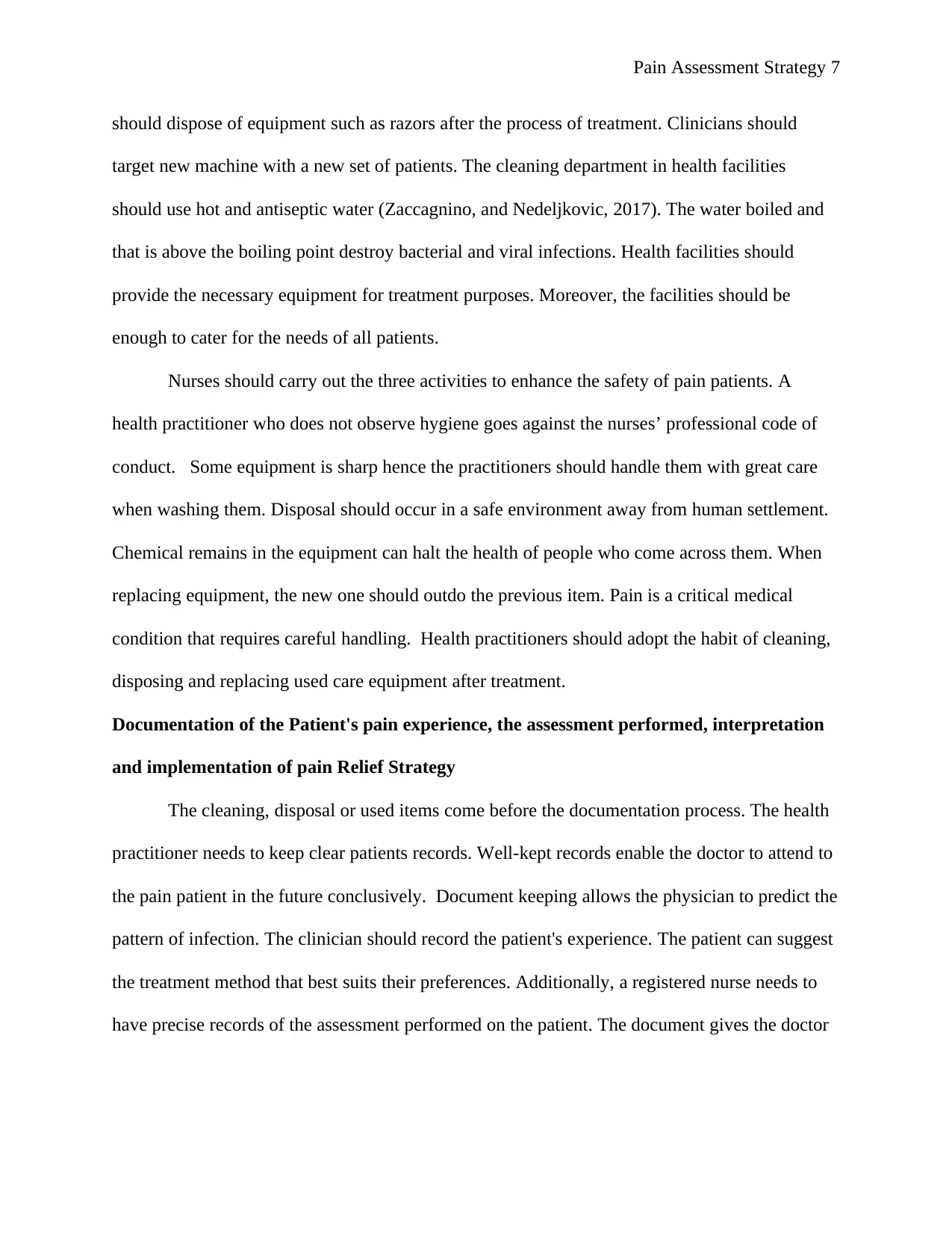
Pain Assessment Strategy 7
should dispose of equipment such as razors after the process of treatment. Clinicians should
target new machine with a new set of patients. The cleaning department in health facilities
should use hot and antiseptic water (Zaccagnino, and Nedeljkovic, 2017). The water boiled and
that is above the boiling point destroy bacterial and viral infections. Health facilities should
provide the necessary equipment for treatment purposes. Moreover, the facilities should be
enough to cater for the needs of all patients.
Nurses should carry out the three activities to enhance the safety of pain patients. A
health practitioner who does not observe hygiene goes against the nurses’ professional code of
conduct. Some equipment is sharp hence the practitioners should handle them with great care
when washing them. Disposal should occur in a safe environment away from human settlement.
Chemical remains in the equipment can halt the health of people who come across them. When
replacing equipment, the new one should outdo the previous item. Pain is a critical medical
condition that requires careful handling. Health practitioners should adopt the habit of cleaning,
disposing and replacing used care equipment after treatment.
Documentation of the Patient's pain experience, the assessment performed, interpretation
and implementation of pain Relief Strategy
The cleaning, disposal or used items come before the documentation process. The health
practitioner needs to keep clear patients records. Well-kept records enable the doctor to attend to
the pain patient in the future conclusively. Document keeping allows the physician to predict the
pattern of infection. The clinician should record the patient's experience. The patient can suggest
the treatment method that best suits their preferences. Additionally, a registered nurse needs to
have precise records of the assessment performed on the patient. The document gives the doctor
should dispose of equipment such as razors after the process of treatment. Clinicians should
target new machine with a new set of patients. The cleaning department in health facilities
should use hot and antiseptic water (Zaccagnino, and Nedeljkovic, 2017). The water boiled and
that is above the boiling point destroy bacterial and viral infections. Health facilities should
provide the necessary equipment for treatment purposes. Moreover, the facilities should be
enough to cater for the needs of all patients.
Nurses should carry out the three activities to enhance the safety of pain patients. A
health practitioner who does not observe hygiene goes against the nurses’ professional code of
conduct. Some equipment is sharp hence the practitioners should handle them with great care
when washing them. Disposal should occur in a safe environment away from human settlement.
Chemical remains in the equipment can halt the health of people who come across them. When
replacing equipment, the new one should outdo the previous item. Pain is a critical medical
condition that requires careful handling. Health practitioners should adopt the habit of cleaning,
disposing and replacing used care equipment after treatment.
Documentation of the Patient's pain experience, the assessment performed, interpretation
and implementation of pain Relief Strategy
The cleaning, disposal or used items come before the documentation process. The health
practitioner needs to keep clear patients records. Well-kept records enable the doctor to attend to
the pain patient in the future conclusively. Document keeping allows the physician to predict the
pattern of infection. The clinician should record the patient's experience. The patient can suggest
the treatment method that best suits their preferences. Additionally, a registered nurse needs to
have precise records of the assessment performed on the patient. The document gives the doctor
Paraphrase This Document
Need a fresh take? Get an instant paraphrase of this document with our AI Paraphraser
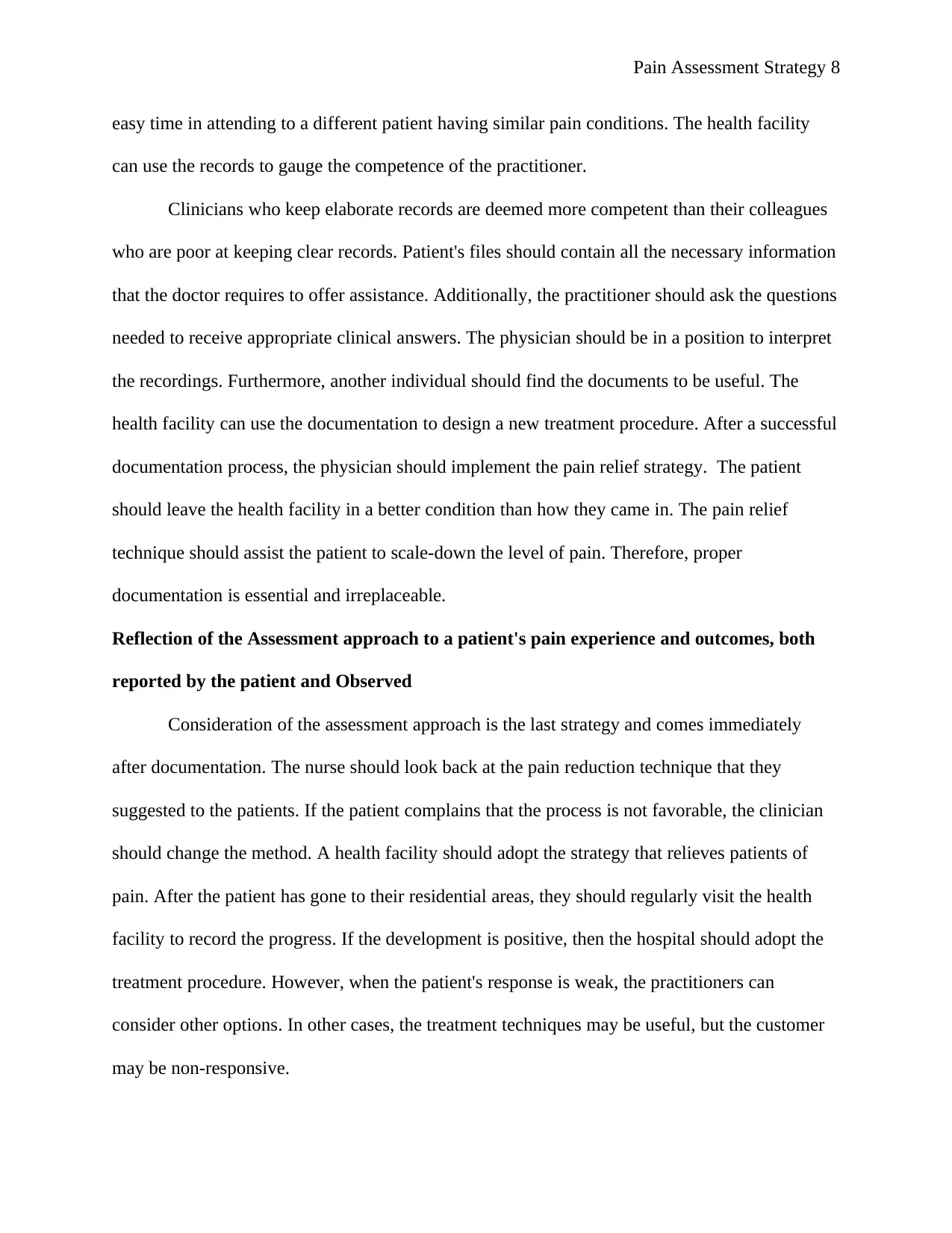
Pain Assessment Strategy 8
easy time in attending to a different patient having similar pain conditions. The health facility
can use the records to gauge the competence of the practitioner.
Clinicians who keep elaborate records are deemed more competent than their colleagues
who are poor at keeping clear records. Patient's files should contain all the necessary information
that the doctor requires to offer assistance. Additionally, the practitioner should ask the questions
needed to receive appropriate clinical answers. The physician should be in a position to interpret
the recordings. Furthermore, another individual should find the documents to be useful. The
health facility can use the documentation to design a new treatment procedure. After a successful
documentation process, the physician should implement the pain relief strategy. The patient
should leave the health facility in a better condition than how they came in. The pain relief
technique should assist the patient to scale-down the level of pain. Therefore, proper
documentation is essential and irreplaceable.
Reflection of the Assessment approach to a patient's pain experience and outcomes, both
reported by the patient and Observed
Consideration of the assessment approach is the last strategy and comes immediately
after documentation. The nurse should look back at the pain reduction technique that they
suggested to the patients. If the patient complains that the process is not favorable, the clinician
should change the method. A health facility should adopt the strategy that relieves patients of
pain. After the patient has gone to their residential areas, they should regularly visit the health
facility to record the progress. If the development is positive, then the hospital should adopt the
treatment procedure. However, when the patient's response is weak, the practitioners can
consider other options. In other cases, the treatment techniques may be useful, but the customer
may be non-responsive.
easy time in attending to a different patient having similar pain conditions. The health facility
can use the records to gauge the competence of the practitioner.
Clinicians who keep elaborate records are deemed more competent than their colleagues
who are poor at keeping clear records. Patient's files should contain all the necessary information
that the doctor requires to offer assistance. Additionally, the practitioner should ask the questions
needed to receive appropriate clinical answers. The physician should be in a position to interpret
the recordings. Furthermore, another individual should find the documents to be useful. The
health facility can use the documentation to design a new treatment procedure. After a successful
documentation process, the physician should implement the pain relief strategy. The patient
should leave the health facility in a better condition than how they came in. The pain relief
technique should assist the patient to scale-down the level of pain. Therefore, proper
documentation is essential and irreplaceable.
Reflection of the Assessment approach to a patient's pain experience and outcomes, both
reported by the patient and Observed
Consideration of the assessment approach is the last strategy and comes immediately
after documentation. The nurse should look back at the pain reduction technique that they
suggested to the patients. If the patient complains that the process is not favorable, the clinician
should change the method. A health facility should adopt the strategy that relieves patients of
pain. After the patient has gone to their residential areas, they should regularly visit the health
facility to record the progress. If the development is positive, then the hospital should adopt the
treatment procedure. However, when the patient's response is weak, the practitioners can
consider other options. In other cases, the treatment techniques may be useful, but the customer
may be non-responsive.
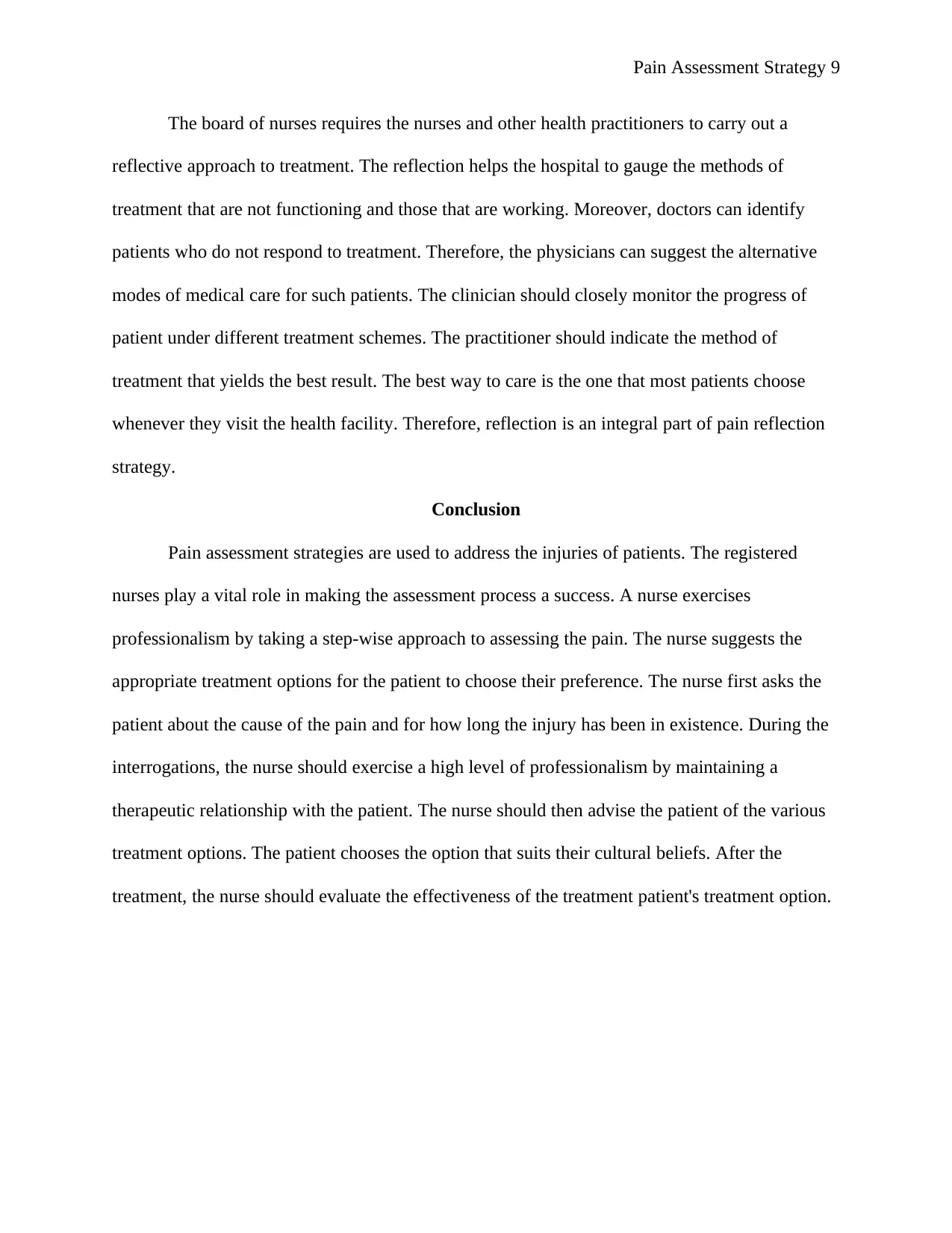
Pain Assessment Strategy 9
The board of nurses requires the nurses and other health practitioners to carry out a
reflective approach to treatment. The reflection helps the hospital to gauge the methods of
treatment that are not functioning and those that are working. Moreover, doctors can identify
patients who do not respond to treatment. Therefore, the physicians can suggest the alternative
modes of medical care for such patients. The clinician should closely monitor the progress of
patient under different treatment schemes. The practitioner should indicate the method of
treatment that yields the best result. The best way to care is the one that most patients choose
whenever they visit the health facility. Therefore, reflection is an integral part of pain reflection
strategy.
Conclusion
Pain assessment strategies are used to address the injuries of patients. The registered
nurses play a vital role in making the assessment process a success. A nurse exercises
professionalism by taking a step-wise approach to assessing the pain. The nurse suggests the
appropriate treatment options for the patient to choose their preference. The nurse first asks the
patient about the cause of the pain and for how long the injury has been in existence. During the
interrogations, the nurse should exercise a high level of professionalism by maintaining a
therapeutic relationship with the patient. The nurse should then advise the patient of the various
treatment options. The patient chooses the option that suits their cultural beliefs. After the
treatment, the nurse should evaluate the effectiveness of the treatment patient's treatment option.
The board of nurses requires the nurses and other health practitioners to carry out a
reflective approach to treatment. The reflection helps the hospital to gauge the methods of
treatment that are not functioning and those that are working. Moreover, doctors can identify
patients who do not respond to treatment. Therefore, the physicians can suggest the alternative
modes of medical care for such patients. The clinician should closely monitor the progress of
patient under different treatment schemes. The practitioner should indicate the method of
treatment that yields the best result. The best way to care is the one that most patients choose
whenever they visit the health facility. Therefore, reflection is an integral part of pain reflection
strategy.
Conclusion
Pain assessment strategies are used to address the injuries of patients. The registered
nurses play a vital role in making the assessment process a success. A nurse exercises
professionalism by taking a step-wise approach to assessing the pain. The nurse suggests the
appropriate treatment options for the patient to choose their preference. The nurse first asks the
patient about the cause of the pain and for how long the injury has been in existence. During the
interrogations, the nurse should exercise a high level of professionalism by maintaining a
therapeutic relationship with the patient. The nurse should then advise the patient of the various
treatment options. The patient chooses the option that suits their cultural beliefs. After the
treatment, the nurse should evaluate the effectiveness of the treatment patient's treatment option.
⊘ This is a preview!⊘
Do you want full access?
Subscribe today to unlock all pages.

Trusted by 1+ million students worldwide
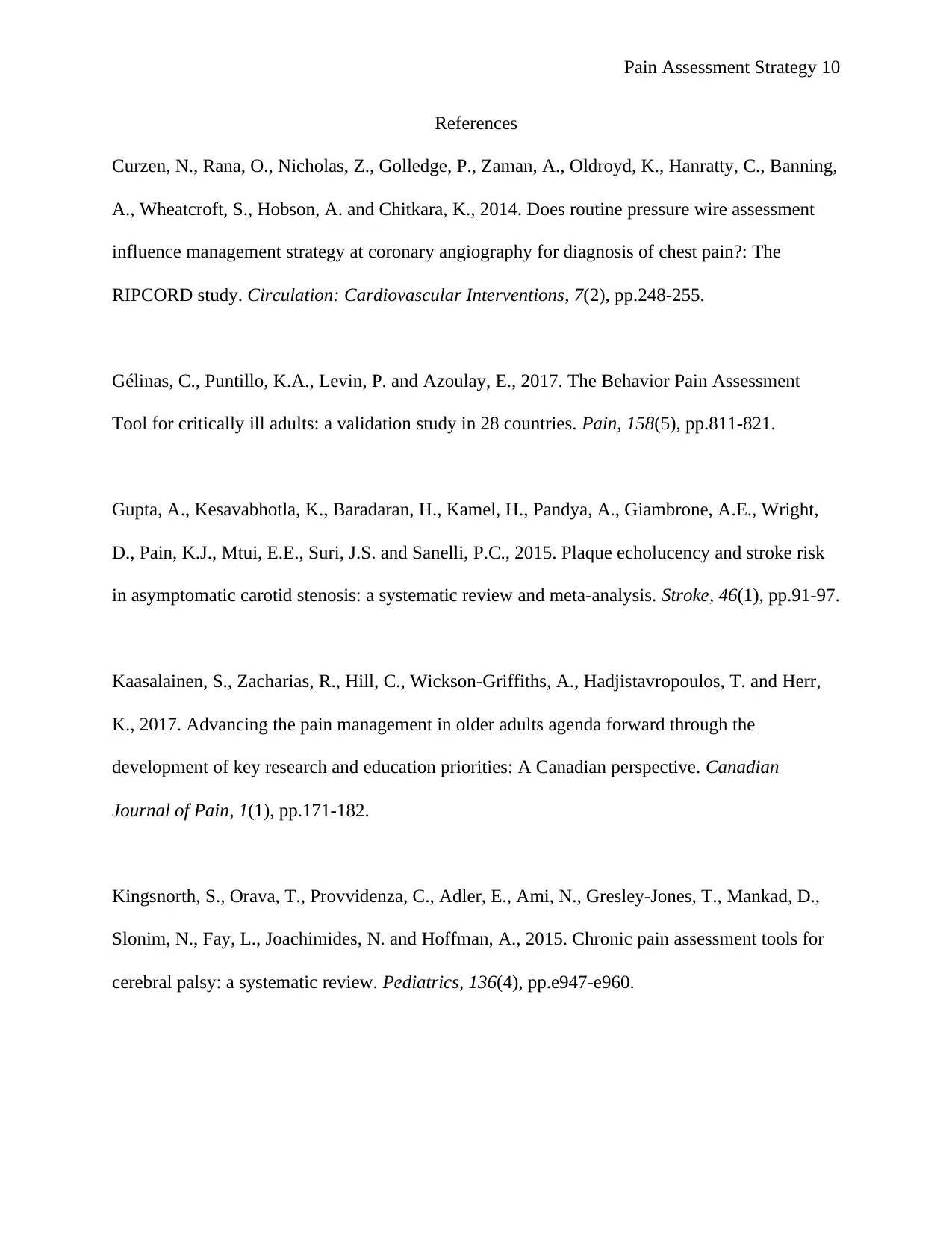
Pain Assessment Strategy 10
References
Curzen, N., Rana, O., Nicholas, Z., Golledge, P., Zaman, A., Oldroyd, K., Hanratty, C., Banning,
A., Wheatcroft, S., Hobson, A. and Chitkara, K., 2014. Does routine pressure wire assessment
influence management strategy at coronary angiography for diagnosis of chest pain?: The
RIPCORD study. Circulation: Cardiovascular Interventions, 7(2), pp.248-255.
Gélinas, C., Puntillo, K.A., Levin, P. and Azoulay, E., 2017. The Behavior Pain Assessment
Tool for critically ill adults: a validation study in 28 countries. Pain, 158(5), pp.811-821.
Gupta, A., Kesavabhotla, K., Baradaran, H., Kamel, H., Pandya, A., Giambrone, A.E., Wright,
D., Pain, K.J., Mtui, E.E., Suri, J.S. and Sanelli, P.C., 2015. Plaque echolucency and stroke risk
in asymptomatic carotid stenosis: a systematic review and meta-analysis. Stroke, 46(1), pp.91-97.
Kaasalainen, S., Zacharias, R., Hill, C., Wickson-Griffiths, A., Hadjistavropoulos, T. and Herr,
K., 2017. Advancing the pain management in older adults agenda forward through the
development of key research and education priorities: A Canadian perspective. Canadian
Journal of Pain, 1(1), pp.171-182.
Kingsnorth, S., Orava, T., Provvidenza, C., Adler, E., Ami, N., Gresley-Jones, T., Mankad, D.,
Slonim, N., Fay, L., Joachimides, N. and Hoffman, A., 2015. Chronic pain assessment tools for
cerebral palsy: a systematic review. Pediatrics, 136(4), pp.e947-e960.
References
Curzen, N., Rana, O., Nicholas, Z., Golledge, P., Zaman, A., Oldroyd, K., Hanratty, C., Banning,
A., Wheatcroft, S., Hobson, A. and Chitkara, K., 2014. Does routine pressure wire assessment
influence management strategy at coronary angiography for diagnosis of chest pain?: The
RIPCORD study. Circulation: Cardiovascular Interventions, 7(2), pp.248-255.
Gélinas, C., Puntillo, K.A., Levin, P. and Azoulay, E., 2017. The Behavior Pain Assessment
Tool for critically ill adults: a validation study in 28 countries. Pain, 158(5), pp.811-821.
Gupta, A., Kesavabhotla, K., Baradaran, H., Kamel, H., Pandya, A., Giambrone, A.E., Wright,
D., Pain, K.J., Mtui, E.E., Suri, J.S. and Sanelli, P.C., 2015. Plaque echolucency and stroke risk
in asymptomatic carotid stenosis: a systematic review and meta-analysis. Stroke, 46(1), pp.91-97.
Kaasalainen, S., Zacharias, R., Hill, C., Wickson-Griffiths, A., Hadjistavropoulos, T. and Herr,
K., 2017. Advancing the pain management in older adults agenda forward through the
development of key research and education priorities: A Canadian perspective. Canadian
Journal of Pain, 1(1), pp.171-182.
Kingsnorth, S., Orava, T., Provvidenza, C., Adler, E., Ami, N., Gresley-Jones, T., Mankad, D.,
Slonim, N., Fay, L., Joachimides, N. and Hoffman, A., 2015. Chronic pain assessment tools for
cerebral palsy: a systematic review. Pediatrics, 136(4), pp.e947-e960.
Paraphrase This Document
Need a fresh take? Get an instant paraphrase of this document with our AI Paraphraser
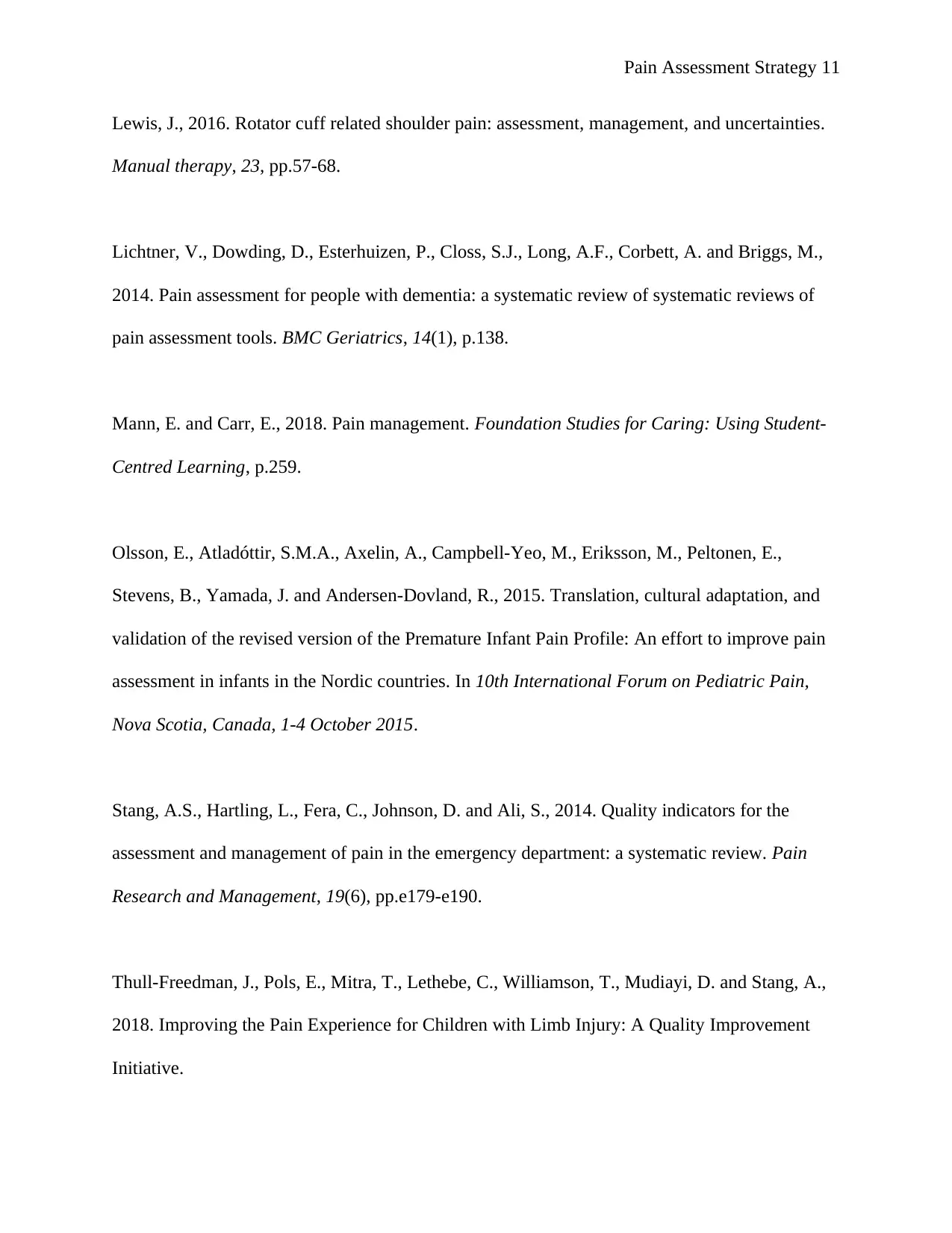
Pain Assessment Strategy 11
Lewis, J., 2016. Rotator cuff related shoulder pain: assessment, management, and uncertainties.
Manual therapy, 23, pp.57-68.
Lichtner, V., Dowding, D., Esterhuizen, P., Closs, S.J., Long, A.F., Corbett, A. and Briggs, M.,
2014. Pain assessment for people with dementia: a systematic review of systematic reviews of
pain assessment tools. BMC Geriatrics, 14(1), p.138.
Mann, E. and Carr, E., 2018. Pain management. Foundation Studies for Caring: Using Student-
Centred Learning, p.259.
Olsson, E., Atladóttir, S.M.A., Axelin, A., Campbell-Yeo, M., Eriksson, M., Peltonen, E.,
Stevens, B., Yamada, J. and Andersen-Dovland, R., 2015. Translation, cultural adaptation, and
validation of the revised version of the Premature Infant Pain Profile: An effort to improve pain
assessment in infants in the Nordic countries. In 10th International Forum on Pediatric Pain,
Nova Scotia, Canada, 1-4 October 2015.
Stang, A.S., Hartling, L., Fera, C., Johnson, D. and Ali, S., 2014. Quality indicators for the
assessment and management of pain in the emergency department: a systematic review. Pain
Research and Management, 19(6), pp.e179-e190.
Thull-Freedman, J., Pols, E., Mitra, T., Lethebe, C., Williamson, T., Mudiayi, D. and Stang, A.,
2018. Improving the Pain Experience for Children with Limb Injury: A Quality Improvement
Initiative.
Lewis, J., 2016. Rotator cuff related shoulder pain: assessment, management, and uncertainties.
Manual therapy, 23, pp.57-68.
Lichtner, V., Dowding, D., Esterhuizen, P., Closs, S.J., Long, A.F., Corbett, A. and Briggs, M.,
2014. Pain assessment for people with dementia: a systematic review of systematic reviews of
pain assessment tools. BMC Geriatrics, 14(1), p.138.
Mann, E. and Carr, E., 2018. Pain management. Foundation Studies for Caring: Using Student-
Centred Learning, p.259.
Olsson, E., Atladóttir, S.M.A., Axelin, A., Campbell-Yeo, M., Eriksson, M., Peltonen, E.,
Stevens, B., Yamada, J. and Andersen-Dovland, R., 2015. Translation, cultural adaptation, and
validation of the revised version of the Premature Infant Pain Profile: An effort to improve pain
assessment in infants in the Nordic countries. In 10th International Forum on Pediatric Pain,
Nova Scotia, Canada, 1-4 October 2015.
Stang, A.S., Hartling, L., Fera, C., Johnson, D. and Ali, S., 2014. Quality indicators for the
assessment and management of pain in the emergency department: a systematic review. Pain
Research and Management, 19(6), pp.e179-e190.
Thull-Freedman, J., Pols, E., Mitra, T., Lethebe, C., Williamson, T., Mudiayi, D. and Stang, A.,
2018. Improving the Pain Experience for Children with Limb Injury: A Quality Improvement
Initiative.
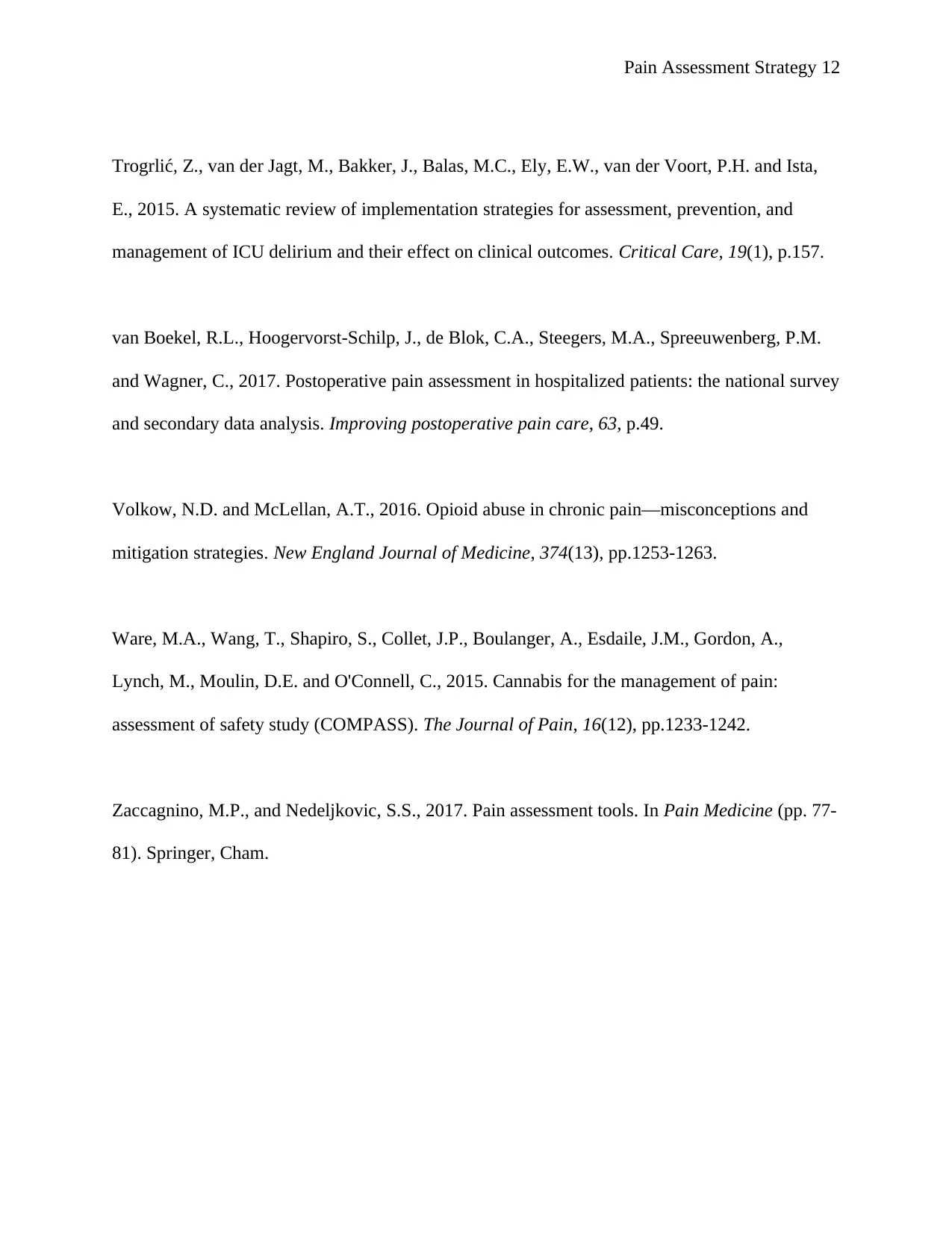
Pain Assessment Strategy 12
Trogrlić, Z., van der Jagt, M., Bakker, J., Balas, M.C., Ely, E.W., van der Voort, P.H. and Ista,
E., 2015. A systematic review of implementation strategies for assessment, prevention, and
management of ICU delirium and their effect on clinical outcomes. Critical Care, 19(1), p.157.
van Boekel, R.L., Hoogervorst-Schilp, J., de Blok, C.A., Steegers, M.A., Spreeuwenberg, P.M.
and Wagner, C., 2017. Postoperative pain assessment in hospitalized patients: the national survey
and secondary data analysis. Improving postoperative pain care, 63, p.49.
Volkow, N.D. and McLellan, A.T., 2016. Opioid abuse in chronic pain—misconceptions and
mitigation strategies. New England Journal of Medicine, 374(13), pp.1253-1263.
Ware, M.A., Wang, T., Shapiro, S., Collet, J.P., Boulanger, A., Esdaile, J.M., Gordon, A.,
Lynch, M., Moulin, D.E. and O'Connell, C., 2015. Cannabis for the management of pain:
assessment of safety study (COMPASS). The Journal of Pain, 16(12), pp.1233-1242.
Zaccagnino, M.P., and Nedeljkovic, S.S., 2017. Pain assessment tools. In Pain Medicine (pp. 77-
81). Springer, Cham.
Trogrlić, Z., van der Jagt, M., Bakker, J., Balas, M.C., Ely, E.W., van der Voort, P.H. and Ista,
E., 2015. A systematic review of implementation strategies for assessment, prevention, and
management of ICU delirium and their effect on clinical outcomes. Critical Care, 19(1), p.157.
van Boekel, R.L., Hoogervorst-Schilp, J., de Blok, C.A., Steegers, M.A., Spreeuwenberg, P.M.
and Wagner, C., 2017. Postoperative pain assessment in hospitalized patients: the national survey
and secondary data analysis. Improving postoperative pain care, 63, p.49.
Volkow, N.D. and McLellan, A.T., 2016. Opioid abuse in chronic pain—misconceptions and
mitigation strategies. New England Journal of Medicine, 374(13), pp.1253-1263.
Ware, M.A., Wang, T., Shapiro, S., Collet, J.P., Boulanger, A., Esdaile, J.M., Gordon, A.,
Lynch, M., Moulin, D.E. and O'Connell, C., 2015. Cannabis for the management of pain:
assessment of safety study (COMPASS). The Journal of Pain, 16(12), pp.1233-1242.
Zaccagnino, M.P., and Nedeljkovic, S.S., 2017. Pain assessment tools. In Pain Medicine (pp. 77-
81). Springer, Cham.
⊘ This is a preview!⊘
Do you want full access?
Subscribe today to unlock all pages.

Trusted by 1+ million students worldwide
1 out of 12
Related Documents
Your All-in-One AI-Powered Toolkit for Academic Success.
+13062052269
info@desklib.com
Available 24*7 on WhatsApp / Email
![[object Object]](/_next/static/media/star-bottom.7253800d.svg)
Unlock your academic potential
Copyright © 2020–2025 A2Z Services. All Rights Reserved. Developed and managed by ZUCOL.





